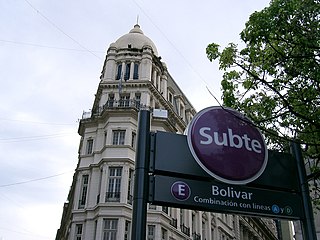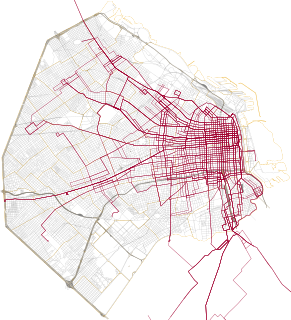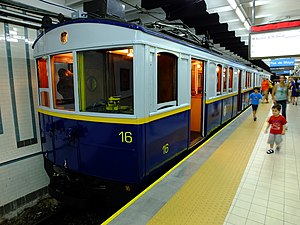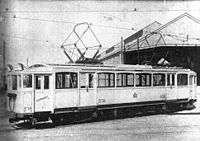
The Buenos Aires Underground, locally known as Subte, is a rapid transit system that serves the area of the city of Buenos Aires, Argentina. The first section of this network opened in 1913, making it the 13th subway in the world and the first underground railway in Latin America, the Southern Hemisphere, and the Spanish-speaking world, with the Madrid Metro opening five years later, in 1919. As of 2022, Buenos Aires is the only Argentine city with a metro system.

Line A is the oldest line of the Buenos Aires Underground. Opened to the public on 1 December 1913, it was the first underground line in South America, the Southern Hemisphere and the Spanish-speaking world. It made Buenos Aires the 13th city in the world to have an underground transport service. The line stretches 9.8 km from Plaza de Mayo and San Pedrito and runs under the full length of the Avenida de Mayo and part of the Avenida Rivadavia, and is used by 258,000 people per day.

Line B of the Buenos Aires Underground runs 11.75 kilometres (7.30 mi) from Leandro N. Alem to Juan Manuel de Rosas in Villa Urquiza. Line B opened to the public on 17 October 1930.

Line C of the Buenos Aires Underground, that runs from Retiro to Constitución terminus, opened on 9 November 1934, and it has a length of 4.3 km (2.7 mi). It runs under such streets as Lima Sur, Bernardo de Irigoyen, Carlos Pellegrini, Esmeralda, la Plaza San Martín and Avenida Ramos Mejia. It not only connects to every other line on the system, but its termini at Retiro and Constitución also connect it to some of the most important commuter rail networks in Buenos Aires, such as the Mitre and Roca lines and also long-distance passenger services. It is thus an important artery in Buenos Aires' transport system. At the same time, it is also the shortest line in both terms of length and number of stations.

Line E of the Buenos Aires Underground, which runs from Retiro to Plaza de los Virreyes, currently extending a total distance of 12 km. Opened in 1944, the Line E was the last completely new line to be added to the Buenos Aires Underground, until 2007 when Line H was opened. The line has a history of being re-routed and extended due to having been historically the line with the lowest passenger numbers on the network.

Caballito is a barrio (neighborhood) of the Argentine capital, Buenos Aires. It is the only barrio in the administrative division Comuna 6.

The Tranvía del Este, also known as the Puerto Madero Tramway, was a 12-block "demonstration" light rail line in the Puerto Madero neighborhood of Buenos Aires, Argentina, in operation from 2007 to 2012. It used French-built Alstom Citadis 302 trams on loan, initially from Mulhouse, France, and later from Madrid, Spain, and was operated by the rail company Ferrovías.

The Premetro is a 7.4-kilometer long (4.6 mi) light rail line that runs in the outskirts of Buenos Aires, connecting with the Buenos Aires Underground line E, at Plaza de los Virreyes station and runs to General Savio, with a short branch to Centro Cívico. It opened in 1987 and is operated by Metrovías. Originally, the Premetro was to include many more lines, but shortly after the privatisation of the railways the projects were postponed and never materialised and only "Premetro E2" was built.

Emepa Group S.A. is an Argentine manufacturer of railway vehicles and owner of Ferrovías, with headquarters located in the city of Buenos Aires. It had formerly owned Ferrocentral, which ran services from Buenos Aires to Córdoba and San Miguel de Tucumán on the Mitre Network, however the state-owned company SOFSE took over these services in 2014 and the subsidiary now remains inactive.

The first trams in Buenos Aires began operating in 1863 in what quickly became a vast network of tramways with the city being known as the "City of Trams" for having the highest tramway-to-population ratio in the world. In the 1920s, Buenos Aires had 875 km (544 mi) of tramways and 99 tram lines using 3000 carriages running throughout the city. By 1963, the vast majority of the network began to be dismantled, though some minor tram services continue in the city today.

The Polvorín Workshop is a rolling stock storage and maintenance workshop in Buenos Aires that primarily serves Line A of the Buenos Aires Underground. It also serves as the main storage and restoration area for the Association of Friends of the Tramway (AAT), who run a heritage tramway in the neighborhood of Caballito, near to where the workshop is located.

The UEC Preston is a tram/subway car built by the British manufacturer United Electric Car Company for the Anglo-Argentine Tramways Company (AATC) in 1912 for use on its then newly built underground tramway in Buenos Aires, which was later to become Line A of the Buenos Aires Underground. Only 4 trams were built and they served on the line up until their retirement in 1977.

The Fiat-Materfer Buenos Aires Underground rolling stock was built by the Argentine company Materfer - then a subsidiary of Fiat Ferroviaria - beginning in 1980 and continuing on through that decade. It was originally conceived to standardise the diverse rolling stock of the Buenos Aires Underground with the use of one model throughout all the lines. However, with the economic and political turmoil faced in the country during and following the collapse of the National Reorganisation Process junta in 1983, its production ended up being far more limited. During the 2010s, the cars were used as temporary stock for two lines, being phased out as newer models arrived from overseas.

The 200 Series is a set of underground cars manufactured by China CNR Corporation and CITIC Construction for use on Line A of the Buenos Aires Underground in Argentina. The cars replace the 100-year-old La Brugeoise cars which operated on the line up until 2013. The Buenos Aires Underground ordered 45 of these units, followed by a further 105 which have been put into service on the line.

The CSR EMU is a series of electric multiple unit cars manufactured by CSR Corporation Limited for use on Buenos Aires' commuter rail network. The trains operate on three of the city's lines as of 2015 and 705 cars were manufactured, with each line using a different number of cars per train. They were created for use on lines electrified using both third rail and overhead lines.

The Siemens-Schuckert Orenstein & Koppel is an underground car formerly used on the Buenos Aires Underground first built by Siemens-Schuckert and Orenstein & Koppel in 1934, 1937 and 1944 with a smaller number of cars built in Argentina during the 1950s. The Siemens O&K rolling stock made up the entirety of the trains used on the three lines built by the Hispanic-Argentine Company for Public Works and Finances (CHADOPyF) and has since served on every line of the Underground from 1934 to 2016, with cars refurbished by the Emepa Group and Alstom continued to function on the network till 2017.
The Buenos Aires Underground has one of the most diverse metro fleets in the world, and has had some of the oldest models in operation on any network. The network began with a relatively standardised fleet, but throughout its over 100-year-long history, it has seen numerous purchases which have created cases where some lines operate numerous models. Recently there have been increased efforts to modernise and standardise the fleets, with large purchases from China CNR Corporation and Alstom.

The Anglo-Argentine Tramways Company, known simply as La Anglo in Argentina, was a large transportation company which operated the majority of the trams in the Buenos Aires network, which was also one of the largest in the world at the time having lines totalling 875 km (544 mi) in length. The company also created Buenos Aires' first underground tram line, which would go on to become Line A of the Buenos Aires Underground. The company also owned other tramways around the country.

The 100 Series are a series of underground railway cars manufactured by Alstom in Brazil and Argentina for use on the Buenos Aires Underground. They are used on Line D of the network, where they make up the vast majority of the fleet, serving alongside some 300 Series and Fiat-Materfer cars. Since 2019, some units have also been used on the Line E.

The 300 Series are a set of underground cars manufactured by Alstom in Brazil for use on the Buenos Aires Underground. They are used on Line H of the network, and more have been introduced on Line D where they operate alongside the similar 100 Series.

























